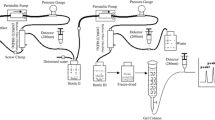Abstract
Lysozyme from Filipino venus (Ruditapes philippinarum) was purified by ion-exchange and gel filtration chromatography. The purification fold and yield were 3,402 and 32.4%, respectively. The molecular weight was determined to be 13.4 kDa by SDS-PAGE. The specific activity of lysozyme was 3.76×105 units/mg protein with Micrococcus lysodeikticus as a substrate. The optimum temperature and pH of lysozyme were 75°C and 5.5, respectively. Lysozyme activity was decreased with about 45% after heat treatment for 30 min at 80°C, and completely inactivated at 100°C. It was activated by NaCl (10–70 mM), MgCl2, and CaCl2 (2–5 mM) whereas it was inhibited by ZnCl2 (2–30 mM).
Similar content being viewed by others
References
Jolles P, Jolles E. What’s new in lysozyme research? Always a model system, today as yesterday. Mol. Cell. Biochem. 63: 165–189 (1984)
Salton MRJ. The properties of lysozyme and its action on microorganisms. Bacteriol. Rev. 21: 82–99 (1957)
Ibrahim HR, Thomas U, Pellegrini A. A helix-loop-helix-peptide at the upper lip of the active site cleft of lysozyme confers potent antimicrobial activity with membrane permeabilization action. J. Biol. Chem. 276: 43767–43774 (2001)
Kornegay JR, Schilling JW, Wilson AC. Molecular adaptation of a leaf-eating bird: Stomach lysozyme of the hoatzin. Mol. Biol. Evol. 11: 921–928 (1994)
Datta S, Janes ME, Xue Q-G, Losso J, La Peyre JF. Control of Listeria monocytogenes and Salmonella anatum on the surface of smoked salmon coated with calcium alginate coating containing oyster lysozyme and nisin. J. Food Sci. 73: M67–M71 (2008)
Mecitoglu C, Yemenicioglu A, Arslanoglu A, Elmaci ZS, Korel F, Cetin AE. Incorporation of partially purified hen egg white lysozyme into zein films for antimicrobial food packaging. Food Res. Int. 39: 12–21 (2006)
Min S, Harris LJ, Han JH, Krochta JM. Listeria monocytogenes inhibition by whey protein films and coatings incorporating lysozyme. J. Food Protect. 68: 2317–2325 (2005)
Ito Y, Yoshikawa A, Hotanii T, Fukuda S, Sugimura K, Imoto T. Amino acid sequences of lysozymes newly purified from invertebrates imply wide distribution of a novel class in the lysozyme family. Eur. J. Biochem. 259: 456–461 (1999)
Xue QG, Schey KL, Volety AK, Chu FL, La Peyre JF. Purification and characterization of lysozyme from plasma of the eastern oyster (Crassostrea virginica). Comp. Biochem. Physiol. 139: 11–25 (2004)
McHenery JG, Birbeck TH. Characterization of the lysozyme of Mytilus edulis (L). Comp. Biochem. Physiol. B 71: 583–589 (1982)
Myrenes B, Johansen A. Recovery of lysozyme from scallop waste. Prep. Biochem. 24: 69–80 (1994)
Bradford MM. A rapid and sensitive method for the quantitation of microgram quantities of protein utilizing the principle of protein-dye binding. Anal. Biochem. 72: 248–254 (1976)
Shugar D. Measurement of lysozyme activity and the ultra violet inactivation of lysozyme. Biochem. Biophys. Acta 8: 302–309 (1952)
Laemmli UK. Cleavage of structural proteins during assembly of the head of bacteriophage T4. Nature 227: 680–685 (1970)
Weber K, Osborn M. The reliability of molecular weight determinations by sodium dodecyl sulfate-polyacrylamide gel electrophoresis. J. Biol. Chem. 244: 4406–4412 (1969)
Lee JM, Kim SM, Kim SM. Biochemical and antibacterial properties of lysozyme purified from the viscera of scallops (Patinopecten yessoensis). J. Food Biochem. 32: 474–489 (2008)
Thammasirirak S, Ponkhan P, Preecharram S, Khanchanuan R, Phonyothee P, Daduang S, Srisomsap C, Araki T, Svasti J. Purification, characterization, and comparison of reptile lysozymes. Comp. Biochem. Physiol. 143: 209–217 (2006)
Lockey TD, Ourth DD. Purification and characterization of lysozyme from hemolymph of Heliothis virescens larvae. Biochem. Bioph. Res. Co. 220: 502–508 (1996)
Schoentgen F, Jolles J, Jolles P. Complete amino acid sequence of ostrich egg-white lysozyme, a goose-type lysozyme. Eur. J. Biochem. 123: 489–497 (1982)
Nilsen IW, Overbo K, Sandsdalen E, Sandaker E, Sletten K, Bjornar M. Protein purification and gene isolation of chlamysin, a cold active lysozyme-like enzyme with antibacterial activity. FEBS Lett. 464: 153–158 (1999)
Miyauchi K, Matsumiya M, Mochizuki A. Purification and characterization of lysozyme from purple Washington clam Saxidomus purpurata. Fisheries Sci. 72: 1300–1305 (2000)
Wang S, Ng TB, Chen T, Lin D, Wu J, Rao P, YE X. First report of a novel plant lysozyme with both antifungal and antibacterial activities. Biochem. Biophys. 327: 820–827 (2005)
Miyauchi K, Matsumiya M, Mochizuki A. Purification and characterization of lysozyme from brackishwater clam Corbicula japonica. Nippon Suisan Gakk. 66: 275–281 (2000)
Wang S, Ye X, Rao P. Isolation of a novel leguminous lysozyme and study on the antifungal activity. Food Res. Int. 47: 341–347 (2012)
Minagawa S, Hikima J, Hirono I, Aoki T. Expression of Japanese flounder cDNA in insect cells. Dev. Comp. Immunol. 25: 439–445 (2001)
Grinde B, Jolles J, Jolles P. Purification and characterization of two lysozymes from rainbow trout (Salmo gairdneri). Eur. J. Biochem. 173: 269–273 (1988)
Fujimoto S, Toshimori-Tsuda I, Kishimoto K, Yamano Y, Morishima I. Protein purification, cDNA cloning, and gene expression of lysozyme from eri-silkworm, Samia Cynthia ricini. Comp. Biochem. Phys. B 128: 709–718 (2001)
Hikima S, Hikima J, Rojtinnakorn J, Hirono I, Aoki T. Characterization and function of kuruma shrimp lysozyme possessing lytic activity against Vibrio species. Gene 316: 187–195 (2003)
Klomklao S, Benjakul S, Visessanguan W, Kishimura H, Simpson BK, Saeki H. Trypsins from yellowfin tuna (Thunnus albacores) spleen: Purification and characterization. Comp. Biochem. Physiol. B 144: 47–56 (2006)
Author information
Authors and Affiliations
Corresponding author
Rights and permissions
About this article
Cite this article
Kim, M., Park, M. & Jeong, Y. Purification and characterization of lysozyme from filipino venus, Ruditapes philippinarum . Food Sci Biotechnol 21, 1463–1468 (2012). https://doi.org/10.1007/s10068-012-0193-z
Received:
Revised:
Accepted:
Published:
Issue Date:
DOI: https://doi.org/10.1007/s10068-012-0193-z



